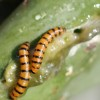Abstract
Since its arrival in the Florida Keys in 1989, this invasive species has become a serious threat to the diversity and abundance of Opuntia cactus in North America. The spread of this moth raises concerns about harm to rare opuntioid species (prickly pear and related cacti), the endangerment of wild opuntioids in the southwestern United States and Mexico, and the consequent effects on entire desert ecosystems and economic hardship for communities in Mexico that cultivate and sell Opuntia. This revised 5-page fact sheet was written by D. H. Habeck, F. D. Bennett, and Christine Miller, and published by the UF Department of Entomology and Nematology, September 2012.
References
Bennett FD, Cock MJW, Hughes IW, Simmonds FJS, Yaseen M. [Cock MJW. (ed.)]. 1985. A review of biological control of pests in the Commonwealth Caribbean and Bermuda up to 1982. Commonwealth Institute Biological Control Technical Committee 9. 218 pp.
Brown RL, Lee S, MacGown JA. (July 2009). Video of the dissection of the male genitalia of the cactus moth, Cactoblastis cactorum. Cactus Moths and Their Relatives (Pyralidae: Phycitinae). (22 August 2012).
Chavez-Ramirez F, Wang XG, Jones K, Hewitt D, Felker P. 1997. Ecological characterization of Opuntia clones in South Texas: Implications for wildlife herbivory and frugivory. Journal of the Professional Association for Cactus Development 2: 9-19.
Dodd AP. 1940. The biological campaign against prickly-pear. Commonwealth Prickly-pear Board Bulletin, Brisbane, 177 pp.
Garcia-Tuduri, Martorell JC, Medina Gaud S. 1971. Geographical distribution and host plant list of the cactus moth Cactoblastis cactorum (Berg) in Puerto Rico and the United States Virgin Islands. Journal of the Agricultural University of Puerto Rico 55: 130-134. https://doi.org/10.46429/jaupr.v55i1.11083
Hight SD, Carpenter JE, Bloem S, Bloem KA. 2005. Developing a sterile insect release program for Cactoblastis cactorum (Berg) (Lepidoptera: Pyralidae): Effective overflooding ratios and release-recapture field studies. Environmental Entomology 34: 850-856. https://doi.org/10.1603/0046-225X-34.4.850
Heinrich C. 1956. American moths of the subfamily Phycitinae. U.S. National Museum Bulletin 207. 581 pp.
Jezorek HA, Stiling PD, Carpenter JE. 2010. Targets of an invasive species: Oviposition preference and larval performance of Cactoblastis cactorum (Lepidoptera: Pyralidae) on 14 North American opuntioid cacti. Environmental Entomology 39: 1884-1892. https://doi.org/10.1603/EN10022
LSU. (July 2009). Cactus Moth. LSU AgCenter Pest Alerts. (22 August 2012).
Marsico TD, Wallace LE, Ervin GN, Brooks CP, McClure JE, Welch ME. 2011. Geographic patterns of genetic diversity from the native range of Cactoblastis cactorum (Berg) support the documented history of invasion and multiple introductions for invasive populations. Biological Invasions 13: 857-868. https://doi.org/10.1007/s10530-010-9874-9
Paraiso O, Hight SD, Kairo MTK, Bloem S. 2011. Egg parasitoids attacking Cactoblastis cactorum (Lepidoptera: Pyralidae) in north Florida. Florida Entomologist 94: 81-90. https://doi.org/10.1653/024.094.0111
Perez-Sandi M. 2001. Addressing the threat of Cactoblastis cactorum (Lepidoptera : Pyralidae), to Opuntia in Mexico. Florida Entomologist 84: 499-502. https://doi.org/10.2307/3496378
Simmonds FJ, Bennett FD. 1966. Biological control of Opuntia spp. by Cactoblastis cactorum in the Leeward Islands (West Indies). Entomophaga 11: 183-189. https://doi.org/10.1007/BF02372940
Soberon J, Golubov J, Sarukhan J. 2001. The importance of Opuntia in Mexico and routes of invasion and impact of Cactoblastis cactorum (Lepidoptera : Pyralidae). Florida Entomologist 84: 486-492. https://doi.org/10.2307/3496376
Starmer WT, Aberdeen VA, Lachance MA. 1987. The yeast community associated with decaying Opuntia stricta (Haworth) in Florida with regard to the moth, Cactoblastis cactorum (Berg). Florida Scientist 51:7-11.
Stiling P, Moon D, Gordon D. 2004. Endangered cactus restoration: Mitigating the non-target effects of a biological control agent (Cactoblastis cactorum) in Florida. Restoration Ecology 12: 605-610. https://doi.org/10.1111/j.1061-2971.2004.00343.x
Vigueras AL, Portillo L. 2001. Uses of Opuntia species and the potential impact of Cactoblastis cactorum (Lepidoptera : Pyralidae) in Mexico. Florida Entomologist 84: 493-498. https://doi.org/10.2307/3496377
Zimmermann HG, Moran VC, Hoffmann JH. 2001. The renowned cactus moth, Cactoblastis cactorum (Lepidoptera: Pyralidae): Its natural history and threat to native Opuntia floras in Mexico and the United States of America. Florida Entomologist 84: 543-551. https://doi.org/10.2307/3496386

